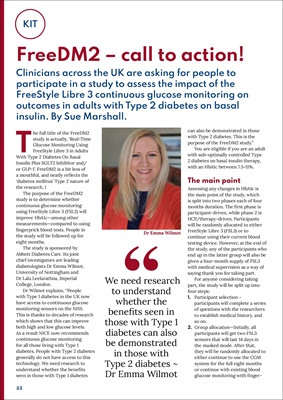
22KIT
We need research
to understand
whether the
benefits seen in
those with Type 1
diabetes can also
be demonstrated
in those with
Type 2 diabetes ~
Dr Emma Wilmot
FreeDM2 - call to action!
Clinicians across the UK are asking for people to
participate in a study to assess the impact of the
FreeStyle Libre 3 continuous glucose monitoring on
outcomes in adults with Type 2 diabetes on basal
insulin. By Sue Marshall.
The full title of the FreeDM2
study is actually, 'Real-Time
Glucose Monitoring Using
FreeStyle Libre 3 in Adults
With Type 2 Diabetes On Basal
Insulin Plus SGLT2 Inhibitor and/
or GLP-1'. FreeDM2 is a bit less of
a mouthful, and neatly reflects the
'diabetes mellitus' Type 2 nature of
the research. I
The purpose of the FreeDM2
study is to determine whether
continuous glucose monitoring
using FreeStyle Libre 3 (FSL3) will
improve HbA1c-among other
measurements-compared to using
fingerprick blood tests. People in
the study will be followed up for
eight months.
The study is sponsored by
Abbott Diabetes Care. Its joint
chief investigators are leading
diabetologists Dr Emma Wilmot,
University of Nottingham and
Dr Lala Leelarathna, Imperial
College, London.
Dr Wilmot explains, "People
with Type 1 diabetes in the UK now
have access to continuous glucose
monitoring sensors on the NHS.
This is thanks to decades of research
which shows that this can improve
both high and low glucose levels.
As a result NICE now recommends
continuous glucose monitoring
for all those living with Type 1
diabetes. People with Type 2 diabetes
generally do not have access to this
technology. We need research to
understand whether the benefits
seen in those with Type 1 diabetes
can also be demonstrated in those
with Type 2 diabetes. This is the
purpose of the FreeDM2 study."
You are eligible if you are an adult
with sub-optimally controlled Type
2 diabetes on basal insulin therapy,
with an HbA1c between 7.5-11%.
The main point
Assessing any changes in HbA1c is
the main point of the study, which
is split into two phases each of four
months duration. The first phase is
participant-driven, while phase 2 is
HCP/therapy-driven. Participants
will be randomly allocated to either
FreeStyle Libre 3 (FSL3) or to
continue using their current blood
testing device. However, at the end of
the study, any of the participants who
end up in the latter group will also be
given a four-month supply of FSL3
with medical supervision as a way of
saying thank you for taking part.
For anyone considering taking
part, the study will be split up into
four steps:
1. Participant selection -
participants will complete a series
of questions with the researchers
to establish medical history, and
so on.
2. Group allocation-Initially, all
participants will get two FSL3
sensors that will last 14 days in
the masked mode. After that,
they will be randomly allocated to
either continue to use the CGM
system for the full eight months
or continue with existing blood
glucose monitoring with fingerDr
Emma Wilmot